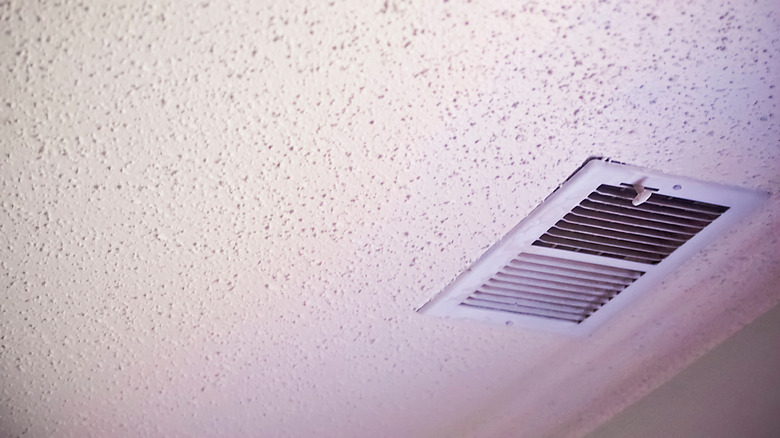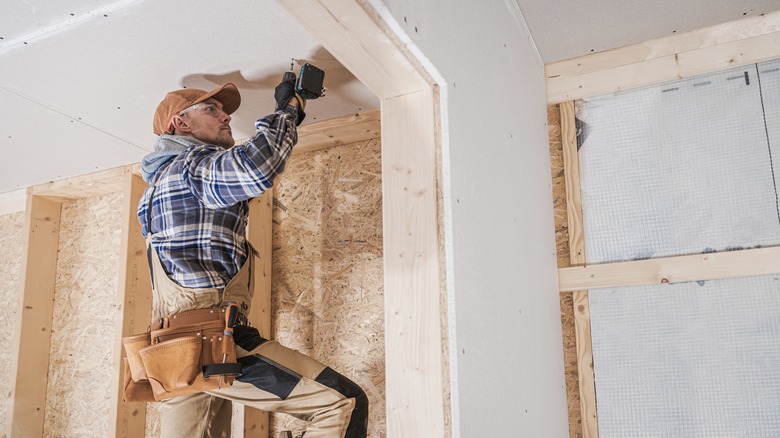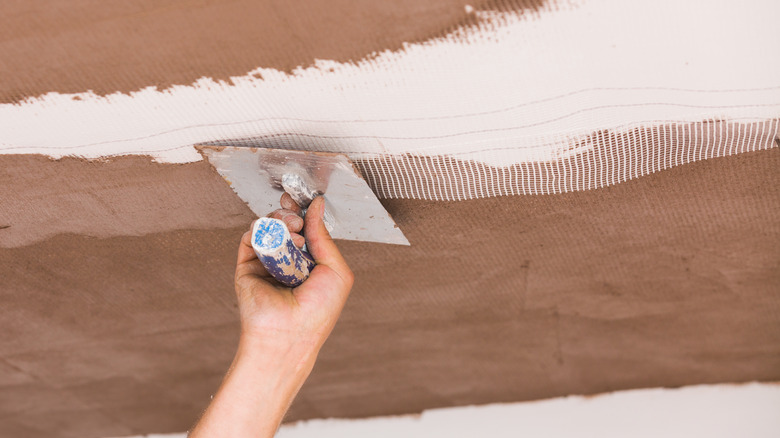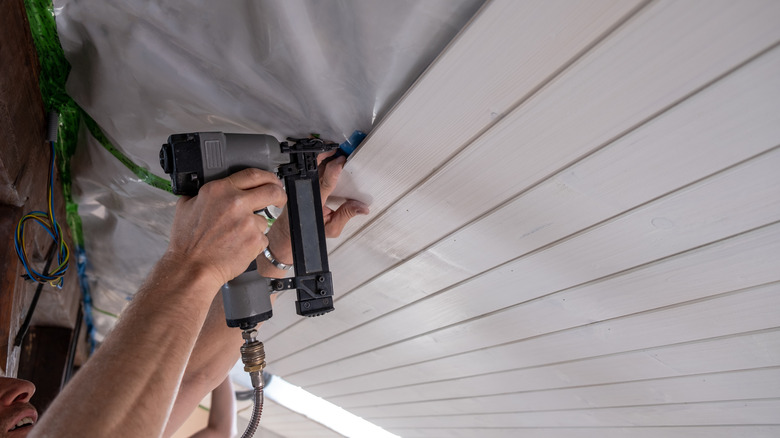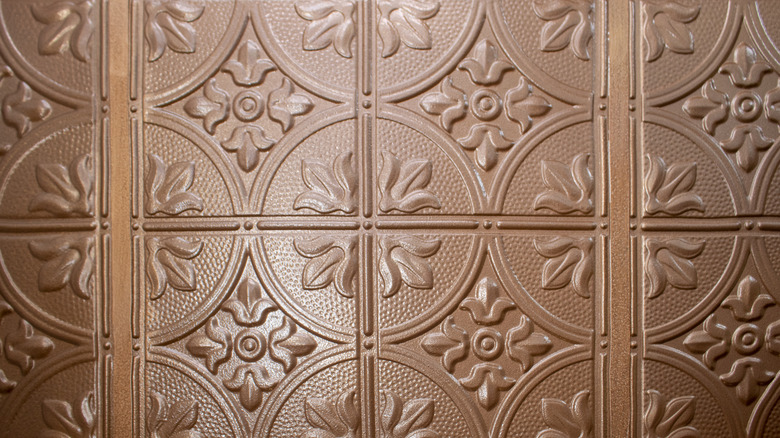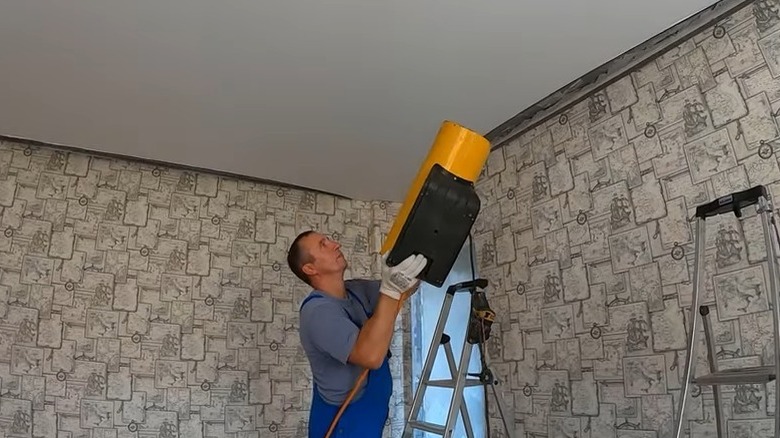5 Genius Ways To Cover Up That Gross Popcorn Ceiling Without Removing It
While once ubiquitous in virtually every home, popcorn ceilings are increasingly considered items of the past. Not only are these outdated, but popcorn ceilings are also loathed due to their appearance, difficulty cleaning, and tendency to make a room look dark. You can technically remove a popcorn ceiling, but this can be a messy, time-consuming project that can also be dangerous due to the risk of asbestos exposure if your home was built before 1980.
If you're intent on getting rid of a popcorn ceiling but aren't keen on totally removing it yourself, you may consider covering it up instead. There are numerous options you can consider with varying styles, materials, and colors to satisfy your taste all while adding character to a room. Budget is also an important consideration, but the good news is you can cover up these ceilings on your own if you have the time and patience. From simple drywalling to more complex tiling, consider the best options you have for covering up a popcorn ceiling.
Cover the popcorn ceiling with drywall
One of the most budget-friendly and straightforward methods of covering a popcorn ceiling is to place drywall directly on top of it. Drywall is made of gypsum plaster and thick paper, and is widely used in walls. When used on ceilings, the material creates a smoother, more polished effect, and can make your ceilings look modern, a stark contrast to popcorn texture. Other perks include fire and sound resistance, as well as insulation. Once the drywall is installed, you can then paint the ceiling in whichever color you desire.
Drywall is cheaper than other more complex methods of ceiling replacement, which makes this option particularly appealing for homeowners on a tighter budget. Perhaps the biggest downside to using drywall for covering popcorn ceilings is they only work on even surfaces. You cannot use pieces of drywall on ceilings that are not flat, such as vaulted ceilings. Another potential problem lies in the dimensions of drywall itself. Due to their weight and size, drywall pieces can be challenging to hold up over your head during the installation process, so you will definitely need someone to assist you. Also be aware that drywall is more susceptible to water damage and mold growth.
Apply a skim coating over the popcorn ceiling
Like drywalling, skim coating is a relatively inexpensive method of covering up a popcorn ceiling. Intended for textured surfaces, the process of skim coating involves sanding down the popcorn texture before applying primer. Then, you apply multiple layers of plaster or joint compound with a putty knife until you've completely covered all traces of popcorn ceiling. As with drywall, skim coating creates a smooth painting surface.
Skim coating walls is budget-friendly, and it can create a smooth surface that is in direct contrast to the previously textured version. If you're considering skim coating a ceiling, know that this is a time-consuming method that requires significant detail to ensure an even application of the compound you're applying. You also need to let each coat of plaster or joint compound dry thoroughly before you apply an additional layer. Otherwise, you could end up with an uneven or textured-appearing ceiling, which are all the qualities of a popcorn ceiling you're trying to get rid of in the first place. There are also safety issues to consider, including making sure your space is well-ventilated, and that you turn off all electricity to the room you're skim coating.
A final consideration is the sanding process required during the prep work. Dry sanding may be off-limits in older homes due to possible asbestos, and it can also make a mess regardless. You may consider wet-sanding the surface instead with a sponge, or skim coat in more layers to thoroughly cover up the popcorn.
Cover the popcorn ceiling with wood planks
If you've always loved the idea of having a wood ceiling, you might consider using wood planks to cover up a popcorn ceiling. You can purchase track-and-clip or tongue-and-groove wooden planks and install them directly on top of the outdated popcorn texture without having to deal with the mess of sanding, drywalling, or skim coating. While natural wood is a more traditional selection, you can add a statement to your room by using painted wood, such as white, beige, gray, and blue. When covering up popcorn ceiling with wooden planks, you'll likely need to cut some of them to fit the space, when applicable.
Wood plank ceilings can certainly add style and make a statement to any room, all while completely covering popcorn ceilings without having to tear the latter down. Perhaps the biggest downside to this method, however, is the higher cost. Just as wood floors are more expensive than other types of flooring, you can expect to pay more to use wood on your ceilings. (The cost will inevitably go up if you have to pay for labor, as well.) However, if you plan on installing ceiling planks yourself, know that these are relatively easy to accomplish due to their light weight. Just know that the process of fitting the planks together on your ceiling can take more time than drywalling.
Cover popcorn ceiling with stone or metal tiles
As another stylish alternative to drywalling and skim coating, tiling can cover popcorn ceilings in the same method as wood planks. There are many styles, colors, and materials to choose from, such as stone and metal. Tin tiled ceilings are making a comeback in modern homes, and they are prized for their ability to make an artistic statement. Tiled ceilings work particularly well in kitchens, living rooms, and other high-traffic areas of your home.
Like wood planks, you may need to cut some of the tiles to ensure they fit on the ceiling. However, tiles are also surprisingly easy to install over an existing ceiling, and they can be screwed directly into place. If you're installing increasingly popular tin tiles, these may be even easier to install, with some manufacturers selling tiles that you simply snap and lock into place. Such methods cut down on both the cost and time spent on tiling a ceiling. The biggest downside of tiled ceilings is the cost. Depending on the material, as well as the design, you can expect to spend at least $400 for a standard room, per Dallas Paints. Another consideration is the thickness of the tiles to place on your ceiling. Since popcorn ceilings aren't completely flat, it may be difficult to affix thicker and heavier tiles, such as those made of stone, versus tin versions.
Consider covering up popcorn texture on your ceiling with stretch fabric
Also called "stretch ceilings," stretch fabric ceilings are yet another method to cover up popcorn texture quickly and easily without spending too much time and money. Stretch fabric is made out of PVC film, and you can buy it in a variety of textures and designs, as well as matte or gloss finishings. It's also a fun way to add art to your ceilings, should you so desire. Stretch fabric ceilings can be used in any room, but can be an opportunity to create a more individual design for a bedroom. Before installation, a tracking system is placed along the edges of the walls a few inches below your original ceiling.
There are several benefits of stretch fabric ceilings. For one, the entire installation process takes just a few hours. You can completely cover up the popcorn ceiling without ever having to touch it, which is a benefit in older homes where asbestos could be a concern. They're also considered eco-friendly, making them safe for children's rooms. While you don't have to prep the ceiling before placement, know that a stretch ceiling does require regular cleanings to help maintain its aesthetic appeal.

